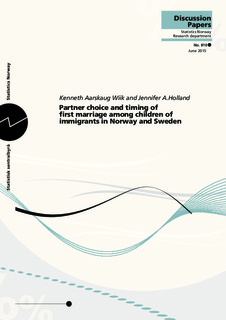Partner choice and timing of first marriage among children of immigrants in Norway and Sweden
Working paper
Published version
Permanent lenke
http://hdl.handle.net/11250/2606861Utgivelsesdato
2015-06Metadata
Vis full innførselSamlinger
- Discussion Papers [1003]
Sammendrag
Using register data from Norway and Sweden, this study addresses the relationship between partner choice and the timing of first marriage among all migrant- and non-migrant-background individuals born between 1972 and 1989, who were either native-born or who immigrated prior to age 18 (generation 1.5). In multivariate models, we analyze the differential hazards of marrying an individual of majority- or migrant-background within a competing risk framework, by migrant generation and number of foreign-born parents. Multivariate results confirmed that in both countries the marital timing patterns of migrant-background individuals who married exogamously were more similar to the majority populations than among those who married another migrant-background individual. Our findings thus suggest that the Scandinavian pattern of late marriage tends to dominate, even where the immigrant-background composition of the couple is mixed. These results are an important starting point for new insights into adaptation drawn from investigations into the family life courses of children of immigrants in Europe, a population sub group currently entering family formation ages.
Beskrivelse
This research was financially supported by the Norwegian Research Council through the FAMGEN project, the Swedish Research Council, and by the European Research Council Starting Grant project “Families of migrant origin: a life course perspective” (project number 263829).
